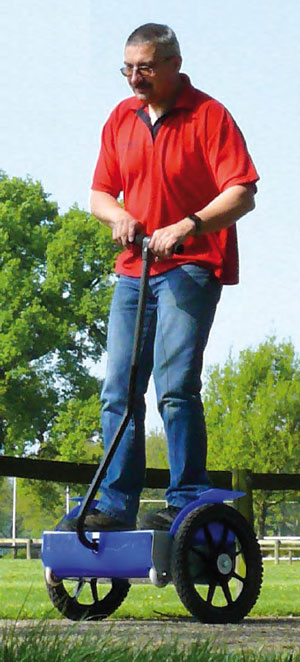ElektorWheelie
The electronics behind a rather special kind of vehicle

In this first article describing our DIY self-balancing single-axle vehicle we look at the electronics modules. An ATmega32 processes the controls and sensor data and drives the two electric motors via power driver stages. It keeps the vehicle balanced and can drive it in any desired direction at any desired speed from stationary to about 11 mph.
Order here:
Materials
Extra info / Update
- The ElektorWheelie vehicle is an open development. The buyer is free to make changes and modifications to the hardware or software of the ElektorWheelie kit, at his/her own risk.
- The use of ElektorWheelie on public roads or in public spaces may be subject to legislation and type approval. No type approval has been applied for and owners are advised to check local or national legislation for any use other than on private land, or with the land owner’s permission.
- Under the terms of an open development Elektor International Media cannot be held liable for any damages or injuries caused by, or arising from, the use, ownership or assembly of the ElektorWheelie vehicle.
Component list
Main PCB
Resistors
R1,R6,R13,R14,R18…R22 = 4k?7
R2 = 100k?
R3,R11,R15 = 10k?
R4 = 2k?2
R5 = 6k?8
R7…R9 = 240?
R10 = 68k?
R12 = 15?
R16 = 150? (2W)
R17 = 1k?
R23…R30 = 4.7?
Capacitors
C1…C3 = 470µF/ 63V
C4...C9,C25 = 4µF7/100V
C10,C21 = 47µF/63V
C11...C17,C20,C22,C24,C26..C34,C36 = 100nF
C18,C19 = 25pF
C23 = 1µF/63V
C35,C37 = 470nF
Semiconductors
D1–D4 = 1N4936
IC1–IC4 = IR2184 (International Rectifier)
T1–T8 = IRF1405 (International Rectifier)
IC5 = ACS755 SCB-100 (Allegro Microsystems)
IC6 = 7805
IC7 = ATMega32 PDIP (Atmel)
IC8,IC9 = 4001N
IC10 = ATTiny25-PDIP (Atmel)
IC11 = MIC2941 (Micrel)
LED1 = LED, 3mm, green
LED2 = LED, 3mm, yellow
LED3 = LED, 3mm, red
Miscellaneous
X1 = 16-MHz crystal
K1,K2 = socket header, 5-mm height, 2.54-mm pitch
K3 = pin header, 5-way, 2.54-mm pitch
K4 = pin header, 2x5-way, 2.54-mm pitch
MA,MB = terminal, 2-way, 6.35-mm pitch
Sensor board
Resistors
R3,R4 = 75?, SMD 1206
Capacitors
C1 = 2µF2/16V, SMD 3216
C16 = 4µF/6V, SMD 3216
C2,C9 = 220nF, SMD 0603
C11,C12 = 1µF, SMD 0603
C3,C4 = 2nF2, SMD 1206
C10 = 100nF, SMD 1206
C14,C15 = 100nF, SMD 1206
Semiconductors
IC1 = IDG-300 QFN40 (Invensense)
IC2 = ADXL320 (Analog Devices)
IC3 = LP2980 (National Semiconductor)
Miscellaneous
K1,K2 = pin header, 10-way, 2.54-mm pitch
Potentiometer, 5k? linear, cermet, 6-mm shaft


Discussion (0 comments)